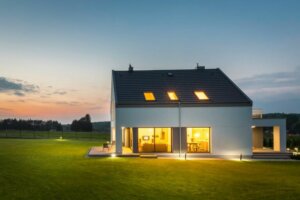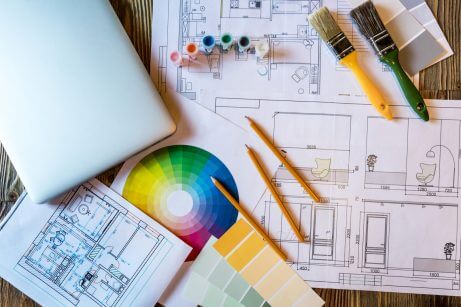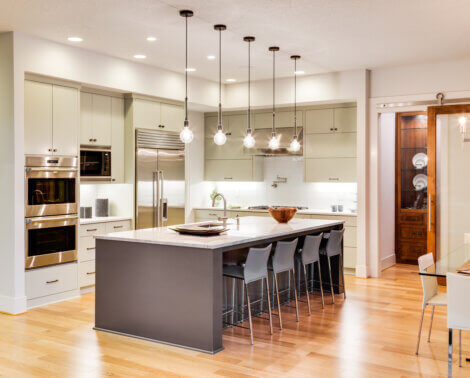Tips to Correctly Illuminate Interiors

Have you ever stopped to think if your house is bright enough? Continue reading because we’re going to clear up your doubts about how to illuminate interiors.
Illuminating interiors isn’t a complicated task, even though at first it seems like it could be. In fact, knowing how to play with artificial and natural light can create different perceptions in the areas of your house.
Of course, you have a lot of questions: How do I light each area? What types of lamps do I choose or how do I create a warmer and pleasant atmosphere? Don’t worry, here you’ll discover some important variables to consider.
A practical guide to illuminate interiors

1.Professional advice
Lighting is one of the pillars of interior design. Because of that, it’s a good idea to get the advice of a professional. Although it seems obvious, often people forget this.
To plan correctly, the expert will need an illustration with measurements of each area. This will include knowing the location of the windows, where there’s light, and the arrangement of the furniture.
2. Factors to consider
In each area, you need to take into account at least four important factors to adequately illuminate: the color of the walls, the size of the room, the type of floor, and the amount of natural lighting that exists.
It’s ideal that the large rooms are divided into zones, alternating general light with atmospheric light and directed light. You’ll find that this is basic to create a cozy ambiance.
3. Determining needs
In order to illuminate interiors adequately, you should think about the activity that takes place in each room. Lighting a room for cooking isn’t the same as lighting a room for sleeping.
Starting from this base, it’ll be easy for you to choose the type of light that’ll meet your needs the best. taking into consideration its characteristics and price.
4. Illuminate interiors by planning light sources
In each room, you should visualize a minimum number of light sources including the ceiling lamps or wall lamps, as well as the floor or table lamps.
For example, in the living room you need, as a minimum, three light sources and two more in the dining room, the bedroom, and the kitchen. Even better, would be to have four in these rooms. In the bathroom, you need a minimum of three.
5. Safe outlets
With the distribution of illumination in a house, besides the number of outlets and switches, you should consider safety a priority to avoid future electrical overloads.
Remember not to locate lights near water sources (they should be one meter apart) to avoid short circuits. If you have small children, cover all of the outlets so that small fingers stay safe.
6. Low consumption bulbs

This type of light bulb is also appropriate for rooms that have the light on for extended periods of time. This includes the kitchen, even though they are turned off and on constantly, it’s not cost-effective.
Take into account that they last ten times longer than traditional bulbs and consume 80% less energy. However, their light isn’t warm and they don’t reflect colors well.
7. Look for the appropriate light to illuminate interiors
When choosing light bulbs, don’t just look for how much electricity they consume, but also for the type of light they give off. Consider if they’re going to adapt to the activity that you’ll be doing in that area.
For instance, avoid fluorescent bulbs in the office or in the dining room. This is because their bluish light doesn’t make food look very appetizing. And in the bathroom avoid using halogen bulbs around the mirror since they make the face look pallid.
8. Illuminate interiors to create cozier spaces
You can increase the capacity of incandescent bulbs to create a warm and relaxing atmosphere. In order to do this use amber lampshades made of glass, fabric, or paper. Also, to achieve a more intimate and cozy effect, opt for indirect lighting around the entire room.

9. Enhance the atmosphere
Lighting and the type of bulbs have an effect on the atmosphere of a room. Therefore, lights that are incandescent give off a yellowish light that’s warmer than the light of halogen bulbs.
In addition, it’s a good idea to consider using pastel-colored bulbs such as softone. These create an atmosphere of warmth and they help to create little areas that you won’t want to leave.
10. Enhance the space
The use of spotlights will allow you to enlarge a room. For example, if you direct the light flow toward the ceiling, it’ll seem higher.
Try to orient the light toward the walls and you’ll see that you’ll obtain a sensation of spaciousness. Also consider, that in areas with very high ceilings you can make them seem lower by aiming the light at the floor.
Do you like these tips to help to improve the rooms in your house? We’re sure that you do!
Have you ever stopped to think if your house is bright enough? Continue reading because we’re going to clear up your doubts about how to illuminate interiors.
Illuminating interiors isn’t a complicated task, even though at first it seems like it could be. In fact, knowing how to play with artificial and natural light can create different perceptions in the areas of your house.
Of course, you have a lot of questions: How do I light each area? What types of lamps do I choose or how do I create a warmer and pleasant atmosphere? Don’t worry, here you’ll discover some important variables to consider.
A practical guide to illuminate interiors

1.Professional advice
Lighting is one of the pillars of interior design. Because of that, it’s a good idea to get the advice of a professional. Although it seems obvious, often people forget this.
To plan correctly, the expert will need an illustration with measurements of each area. This will include knowing the location of the windows, where there’s light, and the arrangement of the furniture.
2. Factors to consider
In each area, you need to take into account at least four important factors to adequately illuminate: the color of the walls, the size of the room, the type of floor, and the amount of natural lighting that exists.
It’s ideal that the large rooms are divided into zones, alternating general light with atmospheric light and directed light. You’ll find that this is basic to create a cozy ambiance.
3. Determining needs
In order to illuminate interiors adequately, you should think about the activity that takes place in each room. Lighting a room for cooking isn’t the same as lighting a room for sleeping.
Starting from this base, it’ll be easy for you to choose the type of light that’ll meet your needs the best. taking into consideration its characteristics and price.
4. Illuminate interiors by planning light sources
In each room, you should visualize a minimum number of light sources including the ceiling lamps or wall lamps, as well as the floor or table lamps.
For example, in the living room you need, as a minimum, three light sources and two more in the dining room, the bedroom, and the kitchen. Even better, would be to have four in these rooms. In the bathroom, you need a minimum of three.
5. Safe outlets
With the distribution of illumination in a house, besides the number of outlets and switches, you should consider safety a priority to avoid future electrical overloads.
Remember not to locate lights near water sources (they should be one meter apart) to avoid short circuits. If you have small children, cover all of the outlets so that small fingers stay safe.
6. Low consumption bulbs

This type of light bulb is also appropriate for rooms that have the light on for extended periods of time. This includes the kitchen, even though they are turned off and on constantly, it’s not cost-effective.
Take into account that they last ten times longer than traditional bulbs and consume 80% less energy. However, their light isn’t warm and they don’t reflect colors well.
7. Look for the appropriate light to illuminate interiors
When choosing light bulbs, don’t just look for how much electricity they consume, but also for the type of light they give off. Consider if they’re going to adapt to the activity that you’ll be doing in that area.
For instance, avoid fluorescent bulbs in the office or in the dining room. This is because their bluish light doesn’t make food look very appetizing. And in the bathroom avoid using halogen bulbs around the mirror since they make the face look pallid.
8. Illuminate interiors to create cozier spaces
You can increase the capacity of incandescent bulbs to create a warm and relaxing atmosphere. In order to do this use amber lampshades made of glass, fabric, or paper. Also, to achieve a more intimate and cozy effect, opt for indirect lighting around the entire room.

9. Enhance the atmosphere
Lighting and the type of bulbs have an effect on the atmosphere of a room. Therefore, lights that are incandescent give off a yellowish light that’s warmer than the light of halogen bulbs.
In addition, it’s a good idea to consider using pastel-colored bulbs such as softone. These create an atmosphere of warmth and they help to create little areas that you won’t want to leave.
10. Enhance the space
The use of spotlights will allow you to enlarge a room. For example, if you direct the light flow toward the ceiling, it’ll seem higher.
Try to orient the light toward the walls and you’ll see that you’ll obtain a sensation of spaciousness. Also consider, that in areas with very high ceilings you can make them seem lower by aiming the light at the floor.
Do you like these tips to help to improve the rooms in your house? We’re sure that you do!







